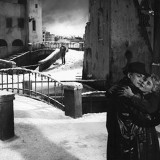Do you believe dreams can come true?
In this masterpiece, adapted from a Russian short story by Fyodor Dostoevsky, Luchino Visconti provides a resounding yes. Or at least it appears like it.

The film was shot in Cinecitta’ studio 5 where 3 years later Fellini would shoot his incredible La Dolce Vita. The choice for filming on a set to depict industrial city Livorno is not accidental; beyond economic reasons shooting mostly night scenes, the artificial set with its elaborate waterways, alleys and bridges, made to resemble Livorno’s Venice quarter – are all meant to communicate the plot’s core fiction element, a Venice-wanna be.
Such a made up settings is used to support the story of two dreamers: Mario (Marcello Mastroianni) who is wandering lonely through the nights (hence “White Nights); and bumps into Natalia (Maria Schell) that is waiting for another guy (Jean Marais) who promised her to return after one year on the bridge.
There is an excellent photography work here as most of the film is dark and contrasted with Natalia’s angel-like bright face with blond hair. Mario, emotional character, falls deeply in love with Natalia, but can she break her promise to the other guy? He is clearly an enigma with sparse details shared about his name and reasons he had to disappear.
The whole business of waiting for a guy for a year on a bridge sounds crazy to Mario who tries to win Natalia’s heart anyway. At times he almost succeeds, but the anxious call of a mother for her daughter to get back home as it’s late, after a long and pleasant evening in a dance hall – wakes up Natalia in one instance to hurry back to the bridge in case her other guy will show up.
[youtube width=”615″ height=”461″]http://www.youtube.com/watch?v=4ihuCh3c6D0[/youtube]
This persistent clinging to a dream for Natalia — where the use of bridges throughout the film are made to symbolize connection between two lost worlds her present and her future with the other guy when he arrives — are at the same time bridges of hope for Mario who is a simple guy, could be any Mario, who simply wants to break his loneliness and find companionship.
Hope on the bridge is contrasted with the dark underworld when the prostitute (Clara Calamai also played in Visconti’s Senso) lures Mario to follow her under the bridge. Yet, another two symbols clashing; the brunette prostitute as the devil versus Natalia the innocent blond – as the angel.
The use of windows open with bright light against dark buildings that suddenly close shut to complete full darkness, is also an interesting visual tactic to convey fleeting hopes. That, and the brooding mysterious soundtrack by maestro Nino Rota provides a foggy dreamlike setting where consequences are constantly looming but you can’t really tell bad or good.
The snow scene under the bridge is one of the most memorable, where the miracle nature of snowfall, serves to further support the fantasy world of the two dreamers and the sheer force in believing that tomorrow indeed will be a great day.
The film also includes insightful behind the scenes interviews with the film’s collaborators such as celebrated screenwriter Suso Cecchi d’Amico. Truly a must see!

